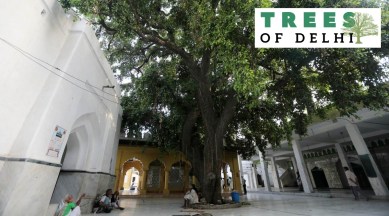Stay updated with the latest - Click here to follow us on Instagram
Trees of Delhi: Capital’s khirni trees tell tales of yore, predating even New Delhi
The khirni tree at the dargah in Chirag Delhi wears small, white flowers along some branches.

Some of Delhi’s shiny-leaved khirni trees can boast of having lived long lives.
The enduring trees stand in the courtyards of the dargahs of Hazrat Nasiruddin Mahmud Chirag Dehlavi in Chirag Delhi and Hazrat Qutubuddin Bakhtiyar Kaki in Mehrauli. These, going by local accounts, are hundreds of years old.
monthly limit of free stories.
with an Express account.
At the dargah in Mehrauli, two large khirni (Manilkara hexandra) trees stand inside the shrine, within a space that is not open to women, but can be spotted through latticed screens.
The khirni tree at the dargah in Chirag Delhi wears small, white flowers along some branches. A few leaves hang dry while others are on the white floors of the quiet dargah. The tree occupies pride of place in the courtyard of the dargah, and is the first thing that meets the eye from the entrance.
The tree bears fruit between May and June and children in the area enjoy it, said Peerzada Javed Ahmad Nasiri, who works at the 14th century dargah in Chirag Delhi. He believes that the long-lasting trees were planted by those who wanted to leave their mark, in the form of trees that would live a long while and provide shade. “This one is around 700 years old. The dargah itself is never too crowded, so when the fruits arrive, children nearby or those who visit the shrine take them,” he said. The tree is rarely watered, he said, though some water from the cleaning of the dargah ends up at its roots.
Pradip Krishen writes in his book Trees of Delhi that the khirni tree can live to a great age, and is a “possible candidate for Delhi’s oldest living tree.” It is found in dry, deciduous evergreen forests as well as coastal forests, he writes. Most khirni trees flower in January.
Krishen writes that the tree can be found on Maulana Azad Marg, Rashtrapati Bhavan, Roshanara Bagh, and Mehrauli.
A sprawling khirni tree also stands opposite the National Museum in Janpath. It has dense clusters of small, dark green leaves with a notch at the apex of the leaf. It stands within the gates of the buildings of the Ministry of External Affairs, close to the boundary wall. This khirni tree, according to Krishen, must “antedate the building of New Delhi by some centuries and may once have graced the fields of Raisina village”.